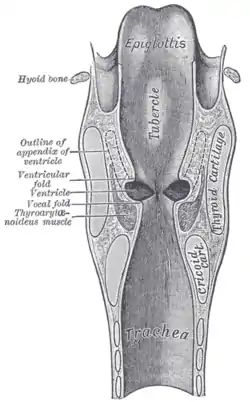Laryngeal saccules
The laryngeal saccules are soft tissue masses that are extensions of the laryngeal ventricles in the larynx. Their function is not well understood, but they may lubricate the vocal cords, and increase the resonance of vocalisation. They may be involved in airway disease and airway obstruction. They may be surgically removed using a laryngeal sacculectomy.
| Laryngeal saccule | |
|---|---|
 A coronal section of the human larynx, showing the laryngeal saccules, labelled appendix of ventricle. | |
| Details | |
| System | larynx |
| Identifiers | |
| Latin | sacculus laryngis |
| TA98 | A06.2.09.011 |
| TA2 | 3207 |
| FMA | 64172 |
| Anatomical terminology | |
Structure
The laryngeal saccules are extensions of the laryngeal ventricles as part of the lateral wall of the larynx.[1] They ascend posterior to the thyroid cartilage.[1] They are surrounded by loose areolar connective tissue.[1] This may contain lymphoid tissue, which is healthy in children and may be a sign of illness in adults.[1]
The laryngeal saccules have pseudostratified columnar epithelium, and contain many mucous glands.[1]
Function
The function of the laryngeal saccules is not well understood.[1] They may help to lubricate the vocal cords, with the contraction of surrounding muscles increasing mucus secretion.[1] In other animals (such as primates), they may increase the resonance of vocalisation.[1]
Clinical significance
The laryngeal saccules may become infected, or become a laryngocoele.[1] They may be assessed during laryngoscopy.[2]
Airway disease
Chronic airway obstruction (caused by stenotic nares, elongated soft palate, or other conditions) can evert the laryngeal saccules.[3] This may aggravate an existing breathing problem. Prolonged airway stress can pull laryngeal walls inward, further obstructing the airway and causing swelling and irritation of the laryngeal membranes. Tracheal collapse may also contribute to a cycle of airway obstruction and airway changes.[4]
In brachycephalic breeds of dog, the saccules can become everted and protrude into the laryngeal opening, causing symptoms such as snoring, noisy breathing, coughing, nasal congestion, and shortness of breath in affected dogs.[5]
References
- Porter, Paul W.; Vilensky, Joel A. (2012). "The laryngeal saccule: Clinical significance". Clinical Anatomy. 25 (5): 647–649. doi:10.1002/ca.22015. ISSN 1098-2353. PMID 22162142. S2CID 33830134.
- Padrid, Philip A. (2011). "10 - Laryngoscopy and Tracheobronchoscopy of the Dog and Cat". Small Animal Endoscopy (3rd ed.). Mosby. pp. 331–359. doi:10.1016/B978-0-323-05578-9.10010-5. ISBN 978-0-323-05578-9.
- Ruaux, Craig (2011). "34 - The Respiratory System". Small Animal Pediatrics - The First 12 Months of Life. Saunders. pp. 328–339. doi:10.1016/B978-1-4160-4889-3.00034-6. ISBN 978-1-4160-4889-3.
- Dr Janice Durr Grepe Ph.D (1998). "The Brachycephalic Syndrome (second part)". Healthy Frenchies: An Owner's Manual. ArDesign (95). Retrieved 2010-02-01.
- William E Schultz, DVM (Fall 2007). "Everted Laryngeal Saccules in the Norwich Terrier" (PDF). Norwich & Norfolk News. Norwich & Norfolk Terrier Club. Retrieved 2010-02-01.
- Broyles, Edwin N. (1959-06-01). "XXXIII Anatomical Observations concerning the Laryngeal Appendix". Annals of Otology, Rhinology & Laryngology. 68 (2): 461–470. doi:10.1177/000348945906800213. ISSN 0003-4894. PMID 13661812. S2CID 74862191.
- Barnes, David R.; Holinger, Lauren D.; Pellettiere, Edmund V. (1980-03-01). "Prolapse of the Laryngeal Ventricle". Otolaryngology–Head and Neck Surgery. 88 (2): 165–171. doi:10.1177/019459988008800213. ISSN 0194-5998. PMID 7402655. S2CID 26178873.